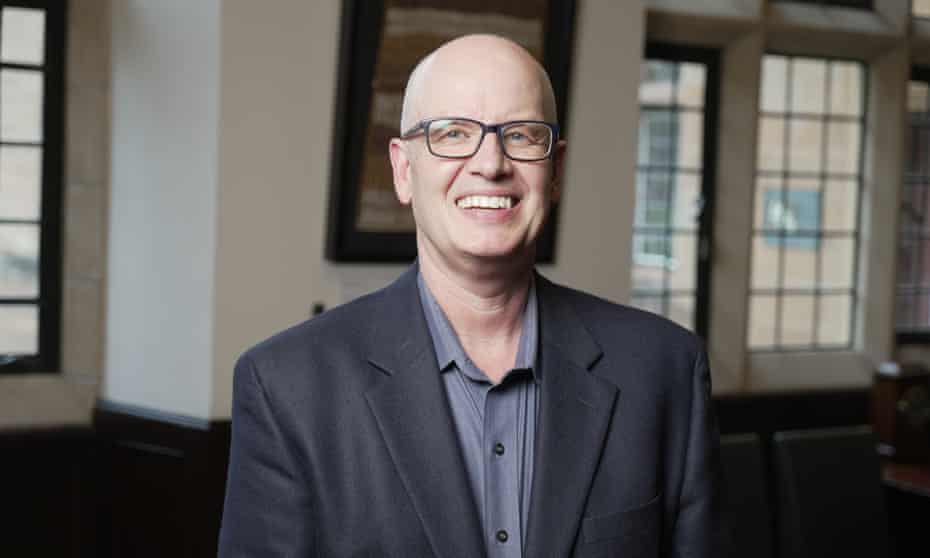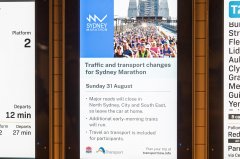悉尼大学的Edward Holmes教授获得了总理科学奖,以表彰他“在科学应对Covid-19方面的变革性作用”。

Holmes教授是病毒性疾病进化方面的专家,他在去年1月首次公开分享了SARS-CoV-2病毒的基因组序列,并代表一个中国科学家联合组发表了该序列。
近三十年来,Holmes研究了病毒如何进化和在物种间跳跃。他的研究重点是包括艾滋病毒、埃博拉病毒和寨卡病毒在内的病原体,他对Covid-19的出现和起源的研究工作使他在2020年被评为新州年度科学家。
在周三的颁奖典礼上受到表彰的其他研究成就包括修复伤口的生物材料的开发,对遥远宇宙中神秘信号的解码,以及提高乳腺癌患者生存率的治疗。
该奖项已进入第22个年头,是澳洲对科学研究、创新和教学成就最负盛名的奖项。
同样来自悉尼大学的Anthony Weiss教授获得了总理创新奖,他开发的生物材料可以加速和改善人体组织的伤口愈合。
他与Holmes教授都获得了25万澳元奖金。
CSIRO的天文学家Keith Bannister博士被授予Malcolm McIntosh年度最佳物理科学家奖。
Bannister博士设计了一种方法来确定快速射电波爆发(FRB)——无线电波的短脉冲——在数十亿光年外的星系中的起源地。
究竟是什么产生了FRB仍然是现代天文学的一个谜,有些人猜测这些来自太空深处的信号可能是外星生命的迹象。
Peter MacCallum癌症中心的肿瘤学家和研究员Sherene Loi教授获得了年度生命科学家Frank Fenner奖。
Loi的研究催生了乳腺癌的生物标志物测试,该测试现在在许多国家的病理学报告中被常规使用。她还帮助证明了免疫疗法可以延长三阴性乳腺癌患者的生存期,这种是最具侵略性的乳腺癌类型。
http://www.theguardian.com/scie ... -coronavirus-genome
评论
没想到,新冠病毒序列是澳洲科学家代表中国科学家联合组发表的
评论
没我
评论
真好,应该重奖
评论
Pfizer BNT162和Moderna都是根据中国的武汉株新冠病毒测序NC_045512做出来的。
测序1月11号公开,1月13号美国科学家就开始根据测序研发疫苗了。
论文最后的通讯作者就是获奖的这位Holmes。
http://www.ncbi.nlm.nih.gov/nuccore/NC_045512
评论
热烈祝贺
评论
福尔摩斯水平可不是盖的
评论
优秀~
评论
哈哈哈~
评论
AUTHORS Wu,F., Zhao,S., Yu,B., Chen,Y.M., Wang,W., Song,Z.G., Hu,Y.,
Tao,Z.W., Tian,J.H., Pei,Y.Y., Yuan,M.L., Zhang,Y.L., Dai,F.H.,
Liu,Y., Wang,Q.M., Zheng,J.J., Xu,L., Holmes,E.C. and Zhang,Y.Z.
最后一位是张永振教授,正是他的实验室完成了这份首次公开的基因序列的测序工作,欧美的医药厂商才可以从1月初就开始开发疫苗。 而他的实验室很快就被中国当局命令关闭!
评论
你的意思是因为私自公布基因序列号所以被关闭?
评论
你不要自以为是地添加 ‘私自’ 两个字!
这次病毒给人类带来了巨大的公共卫生问题,不公布才是私自和自私的!
评论
我问过澳洲某医学教授,中国这个基因编排能力如何
人家说,可以直接移民。。还补了句,你有认识的?
评论
Holmes的名字在倒数第二位置,倒数第一位置的是张永振教授。
评论
对。张永振因为Nature上发表了新冠病毒测序,获得了Nature 2020塑造世界影响力最大的十人。武汉调研后最先提出要封城抑制疫情的李兰娟也凭上了前十。
http://www.nature.com/immersive/d41586-020-03435-6/index.html
virologist Zhang Yongzhen, after days of hesitation, agreed to post online the genome of the virus that was causing pneumonia-like illness in Wuhan, China.
His sharing showed the world that this was a new coronavirus, and similar to the one that caused the deadly 2003 outbreak of SARS (severe acute respiratory syndrome). Researchers immediately pored over the genome to investigate the virus’s key proteins, produce diagnostic tests and design vaccines. “That was the most important day in the COVID-19 outbreak,” says Linfa Wang, a virologist at Duke–National University of Singapore Medical School.
But releasing the sequence was not a straightforward matter. Zhang’s laboratory at the Shanghai Public Health Clinical Center received a sample of the pathogen on 3 January. On the same day, the Chinese government circulated an order forbidding local authorities and labs from publishing information about the virus. After 40 hours of work, at 2 a.m. on 5 January, team member Chen Yan-Mei alerted Zhang that the virus was related to SARS. Later that day, Zhang notified Shanghai’s municipal health authority of the threat and uploaded the data to the National Center for Biotechnology Information (NCBI), a sequence repository run by the US National Institutes of Health.
He then waited for the NCBI to process the upload and send it back for him to review. Over the next few days, he submitted a paper to Nature about the genome and visited Wuhan, where he got first-hand accounts from physicians about the effects of the virus. An editor at Nature urged him to post the sequence. And on 11 January, as Zhang was about to take off on a flight to Beijing, long-time collaborator Edward Holmes, an evolutionary virologist at the University of Sydney in Australia, called him and asked him to release the data online.
Zhang asked Holmes for a minute to think, but the flight attendant was telling him to hang up. He reflected on the grim conversations he’d had in Wuhan. “It was getting serious,” he recalls. “I said, ‘Eddie, I authorize you to release the data.’” Holmes posted it on the website virological.org, and Zhang asked the NCBI to release the genome. Holmes says the team had held off because of the government order, but Zhang says he wasn’t aware of the edict at the time. He does say, however, that he realized some health officials might be angry if he posted the sequence online.
Within two days, Thailand had used the genome to confirm that the virus had crossed the border, and US researchers were using it to design a coronavirus vaccine. But Zhang’s team had received a government ‘rectification’ order and was temporarily unable to study the virus. Some media outlets reported that his team was being punished. Zhang disputes that. He says visiting officials correctly told his lab to update its biosafety protocols after he had moved equipment during construction work. “We were not shut down,” he says: he still worked on influenza, and the team had resumed coronavirus sequencing by the end of January.
He also sees China’s hesitancy to release data as borne of caution not to get things wrong — remembering that in 2003, a prominent Chinese scientist had mistakenly judged SARS to be caused by a bacterium. “I don’t think China’s central government wanted to control information,” he says. “It’s just that some experts lack the experience to make the right decision.
Zhang still marvels at how quickly SARS-CoV-2 was identified. In 2003, scientists took several months to pin down the SARS coronavirus as the cause. Next-generation sequencing technology has made the difference, and Zhang has been one of the most prolific at applying it; he and Holmes have reported thousands of new RNA viruses. Zhang has established a network of labs in China to try to monitor emerging viruses. He hopes to predict and fend off outbreaks before they before they start.
Although he didn’t manage that for SARS-CoV-2, he is proud of the recognition he’s received from scientists all over the world for his data sharing. “They say, ‘January 11 was a turning point for understanding that this is serious. It was a turning point for China. It was a turning point for the world.’”
论文作者排序都是贡献最大的排前面,英文能力强的贡献以写作为主的通讯作者排后面,张永振排名在倒数第二通讯作者Holmes之后。
通讯作者: 往往排在最后。 该位置作者应该是制定蓝图的“导师”, 负责此项目财政的“财神爷”, 和亲手修改草稿, 并定稿的“作家”。 三者往往缺一不可。 通讯作者的身份不仅光荣, 也有其实际的作用, 文章发表后, 一旦有“问题”, 或者要“获奖”, 该作者就是联系人。 要获奖还好办, 要是同行有问题, 该作者首当其冲, 要有能力回答, defend团队的工作。
倒数第二通讯作者: 该作者通常是另一个在不同单位的合作者。 其贡献几乎与主要通讯作者相近: 比如参与技术指导, 课题设计, 财政贡献, 文稿编写,修改。 重要的是, 文章中的内容,当主要通讯这不能denfend的时候, 该作者可以承担起部分责任。
第一作者: 亲自动手做实验,试验, 分析部分结果,数据 (可以是与老板共同讨论), 写出文章第一轮草稿。 第一作者属于该项目的主要动手者, 多数是正在训练期间的学生(包括本,硕,博,博士后,甚至团队里年轻的科研人员)。但是, 这个实验, 项目, 不一定是你自己设计的。
并列第一作者: 这个位置的作者, 其工作强度,参与程度,应该和上述第一作者几乎相同。 但要强调的是, 该作者一定要有对此文章关键的贡献。 其提供的数据同第一作者所为一样重要。如果拿掉该作者提供的图标论证, 此文章就不能在投到目标期刊。 由此可见, 该位置作者不是随便写上去的。
第一与最后作者之间的作者: 即使这些作者, 只要名字在上面, 就意味着他们参与了数据的产生。 或者他们的数据出现在文章里, 或者他们提供本文极为关键的技术或材料
评论
被代表了。
评论
干吗不基于delta 的测序改进疫苗,还停留在alpha的测序?
alpha的测序后花了13个月开放出疫苗,delta出现也有9个月了,为嘛就没有改进版的疫苗,还要继续给孩子打这东西?背后的真相是什么?!
评论
澳洲正在研发第二代疫苗
http://newsroom.unsw.edu.au/new ... n-covid-19-vaccines
评论
澳洲永远领先一步!
评论
辉瑞公司过得和皇帝一样。 没动力
评论
这个要问FDA,药厂早就调整了配方对应delta但FDA说目前没必要急着走程序。
评论
这次人类如此幸运度过危机,都是多亏了科学和技术的发展
否则,这个病毒的死亡率会高达10-20%,根据目前的重症和住院比例
这个病毒直接攻击肺部,要是放在没有现代医学知识的中世纪,一旦进入重症阶段就岌岌可危
澳洲中文论坛热点
- 新西兰总理:出世在新西兰的新纳粹Thomas Sewell是“挺蹩脚的人”,但那是澳洲的问题
- 新西兰总理拉克森称新纳粹Thomas Sewell是坏人,但是没对要求把他从澳大利亚遣返到诞生国去的呼吁置评。
- 撞穿学校栅栏害死十一岁男孩的司机不必坐牢
- 一位女司机撞穿学校栅栏、害死了11岁男孩,被罚2000元罚金、撤消驾照,不必坐牢。Jack Davey 的父母去了
